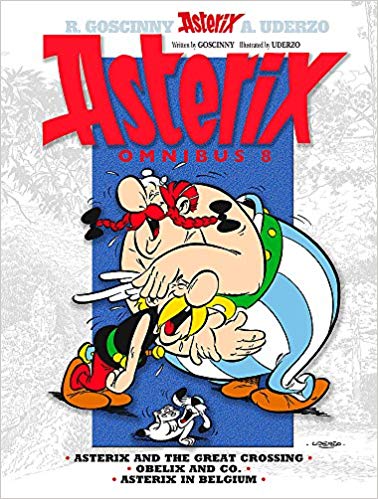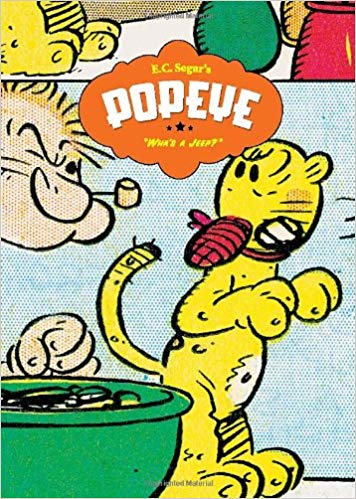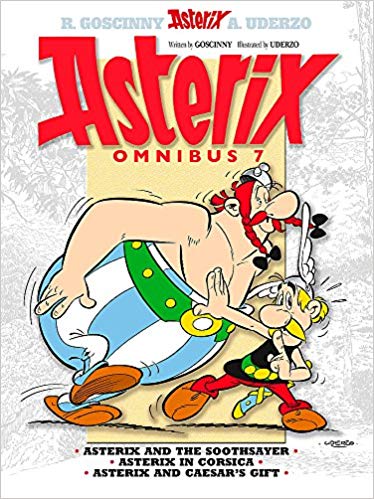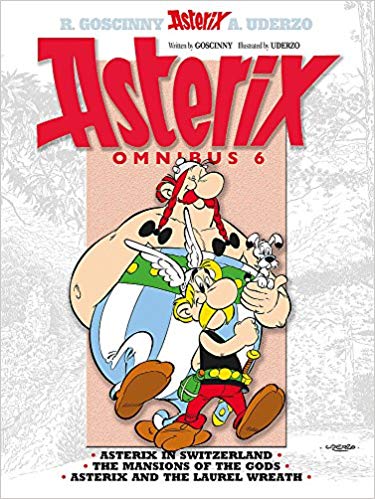
By Goscinny & Uderzo, translated by Anthea Bell & Derek Hockridge (Orion Children’s Books)
ISBN: 978-1-44400-837-1 (HB) 978-1-44400-838-8 (TPB)
One of the most popular comics features on Earth, the collected chronicles of Asterix the Gaul have been translated into more than 100 languages since his debut in 1959, with a dozen animated and live-action movies, TV series, assorted games, toys, merchandise and even a theme park outside Paris (Parc Astérix, unsurprisingly…); all stemming from his gloriously absurd exploits.
More than 325 million copies of unforgettable Asterix books have sold worldwide (not counting the five non-canonical tomes most fans also own), making his joint originators France’s best-selling international authors. There is even the tantalising yet frightening promise of a new – 38th – volume sometime this year by follow-up creative team Jean-Yves Ferri and Didier Conrad…
The diminutive, doughty, potion-powered paragon of Gallic Pride was created by two of the industry’s greatest masters, René Goscinny & Albert Uderzo, as a weekly strip in Pilote, swiftly becoming a national success and symbol. Although their inspirational collaborations ended in 1977 with the death of the prolific scripter, the creative wonderment continued until 2010 from Uderzo and assistants – albeit at a slightly reduced rate.
After nearly 15 years as a comic strip subsequently collected into compilations, in 1974 the 21st tale (Asterix and Caesar’s Gift) was the first to be published as a complete original album before being serialised. Thereafter each new release was a long anticipated, eagerly awaited treat for the strip’s countless aficionados…
The comics magic operates on multiple levels: ostensibly, younger readers revel in the action-packed, lavishly illustrated comedic romps where sneaky, bullying baddies get their just deserts, whilst we more worldly readers enthuse over the dry, pun-filled, sly satire, especially as enhanced for English speakers by the brilliantly light touch of translators Anthea Bell & Derek Hockridge, who played no small part in making the indomitable Gaul and his gallant companions so palatable to the Anglo-Saxon world. (pour moi, though, a perfectly produced physically poetic “Paf!†to the phizzog is as welcome and wondrous as any painfully potent procession of puns or sardonic satirical sideswipes…)
More than half of the canon occurs on Uderzo’s beloved Brittany coast, where, circa 50 B.C., a small village of cantankerous, proudly defiant warriors and their families resisted every effort of the Roman Empire to complete the conquest of Gaul. The land had been divided by the conquerors into the provinces of Celtica, Aquitania and Amorica, but the very tip of the last-cited just refused to be pacified…
The remaining epics take place in various legendary locales throughout the Ancient World, as the Garrulous Gallic Gentlemen visited all the fantastic lands and corners of civilisations of the era…
When the heroes were playing at home, the Romans, unable to defeat the last bastion of Gallic insouciance, futilely resorted to a policy of absolute containment. Thus, the little seaside hamlet was permanently hemmed in by the heavily fortified garrisons of Totorum, Aquarium, Laudanum and Compendium.
The Gauls don’t care: daily defying the world’s greatest military machine simply by going about their everyday affairs, protected by the magic potion of resident druid Getafix and the shrewd wits of the diminutive dynamo and his simplistic, supercharged best friend…
Firmly established as a global brand and premium French export by the mid-1960s, Asterix the Gaul continued to grow in quality as Goscinny & Uderzo toiled ever onward, crafting further fabulous sagas; building a stunning legacy of graphic excellence and storytelling gold. Moreover, following the civil unrest and nigh-revolution in French society following the Paris riots of 1968, the tales took on an increasingly acerbic tang of trenchant satire and pithy socio-political commentary…
La Grande Travers̩e was the 22nd saga and second original book release in France, premiering in 1975, with a British hardcover edition РAsterix and the Great Crossing Рlaunching here the following year.
It begins with another typical village kerfuffle as to the true and relative vintage of Unhygienix the fishmonger’s wares before descending into the standard-issue, boisterous, all-comers-welcome brawl.
However, the situation is rather more serious this time as Druid Getafix needs really fresh fish for the magic potion that keeps them all free of Rome…
A merchant but not a fisherman, Unhygienix refuses to catch his own stock so Asterix and Obelix eventually volunteer to take to sea in old Geriatrix’s dilapidated skiff to replenish the wizard’s stores, even though a big storm is brewing. Sadly, our heroes aren’t fishermen either, and after losing the nets the neophyte seamen are blown far from home…
Lost at sea and starving, they encounter their old pals the Pirates, but Obelix eats all their provisions in one go and soon the mismatched mariners – and faithful mutt Dogmatix – are in even direr straits as another storm blows them ever further westward.
Just as death seems inevitable, the Gauls wash up on an island of the Empire they have never seen before. In this strange outpost the Romans have red skins, paint their faces and wear feathers in their hair. Most terrifyingly, there are no wild boar to eat, only big ugly birds that go “gobble, gobbleâ€â€¦
After the usual two-fisted diplomacy with the “Iberians, or perhaps Thracians?â€, Asterix and Obelix settle down comfortably enough, but the situation changes when the chief decides the big paleface is going to marry his daughter. Desperately, the Gauls steal a canoe one night and strike out across the Big Water towards home but only get as far as a little islet where they’re picked up by Viking explorers Herendethelessen, Steptøånssen, NøgøødreÃ¥ssen, HÃ¥rÃ¥ldwilssen and their valiant Great Dane HuntingseÃ¥ssen, who are all jointly looking for unmapped continents…
Convinced their odd discoveries are natives of this strange New World, the Danes try to entice the oddly eager indigenes to come home with them as proof of Herendethelessen’s incredible discovery. Braving icy Atlantic seas, the dragon ship is soon back in cold, mist-enshrouded Scandinavia where gruff, dismissive Chief Ødiuscomparissen is suitably amazed and astounded…
However, when Gaulish slave Catastrofix reveals they are from his European homeland, tempers get a bit heated and another big fight breaks out…
Taking advantage of the commotion, Asterix, Obelix and Catastrofix – an actual fisherman by trade – steal a boat and head at last for home, picking up some piscine presents for Getafix en route…
This is a wittily arch but delightfully straightforward yarn, big on action and thrills, packed with knowing in-jokes and sly references to other French Western strips such as Lucky Luke and Ompa-pa (Oumpah-pah in French) as well as Shakespeare’s Hamlet, and ultimately formed the basis of the animated feature film Asterix Conquers America.
Strong, stinging satire was the foundation of the next saga. Obélix et Compagnie debuted in 1976 with English-language hardcover Obelix and Co. launching in 1978: once again dealing with frustration-wracked Julius Caesar’s attempting to end the aggravating resistance of the indomitable Gauls.
To that effect the most powerful man in the world dispatches a bold, brash go-getter from the Latin School of Economics to destroy their unity forever. Financial whiz-kid Preposterus has a plan that simply can’t fail and will incidentally pay huge dividends to the Empire.
Meanwhile, the replacing of the Totorum Garrison with fresh troops has allowed the Gauls to give Obelix a truly inspired birthday gift. After beating up the entire contingent on his own and without having to share the soldiers, the delighted big man goes back to carving and delivering Menhirs before meeting a strange young Roman.
Preposterus – a cruelly effective caricature of France’s then Prime Minister Jacques Chirac – intends to destroy the villagers by making them as greedy, lazy and corrupt as any Roman Patrician, all through the introduction of Capitalism and Market Forces…
To that end he pretends to be a Menhir buyer, willing to pay any amount for the giant stone obelisks (which have no appreciable use or worth and were normally swapped for small treats or favours), telling the big gullible oaf that money makes men important and powerful.
Without really understanding, easygoing Obelix begins accepting ever-larger sums for each standing stone, forcing himself to work harder and never stop. He doesn’t know what to do with the money but is caught up in an ever-hastening spiral of production.
Too busy to have fun hunting wild boars or play with Dogmatix, he begins hiring his equally gullible friends and neighbours: first to hunt for him and later to help sculpt Menhirs. All does is work and spend his growing mountain of cash on increasingly daft fancy clothes as he drives himself to miserable exhaustion.
Before long most of the village is caught in the escalating economic bubble, all except wily Asterix, who attempts to bring his old pal to his senses by suggesting to his friends that they set up as rival Menhir manufacturers. The little man is inadvertently helped in this by the status-obsessed village wives who push their men to become as “successful and influential†as the fat oaf…
In Totorum, the megaliths are beginning to pile up as Preposterus proceeds to exhaust all Rome’s funds purchasing Menhirs. Centurion Ignoramus is ecstatic that the plan to destroy the Gauls through cutthroat competition is working, but wants the growing mountain of shaped stones out of his camp, so Preposterous has them shipped back to Rome and starts selling them to rich trendies as indispensable fashion accessories.
The whiz-kid has nearly emptied Caesar’s coffers but his swish and intensive advertising campaign looks sets to recoup the losses with a folk-art sales boom… until sleazy Italian entrepreneur Meretricius starts selling cut-rate Rome-manufactured Menhirs and the Boom leads to a ruthless price war and inevitable Bust which almost topples the Empire…
Meanwhile, success has not made Obelix happy and he’s thinking of quitting, just as the desperate Preposterous returns and inconsiderately, immediately stops buying Menhirs. Of course, being simple peasants the Gauls don’t understand supply and demand or the finer principles of a free market: they’re just really annoyed and frustrated.
Luckily there’s lots of Romans around to help deal with their pent-up tensions…
Soon the air is cleared and the villagers have returned to their old-fashioned ways so Asterix and Getafix can laugh at news of a financial crisis wracking Rome…
This hilarious and telling parody and unashamed anti-Capitalist tract shows Goscinny & Uderzo at their absolute, satirical best, riffing on modern ideologies and dogmas whilst spoofing and lampooning the habits and tactics of greedy bosses and intransigent workers alike. Many politicians and economists have cited this tale – which is as always, stuffed with cameos and in-joke guest shots. I’m reliably informed that the beautiful page 36, which featured Preposterus explaining his ad campaign, was also the 1000th page of Asterix since his debut in 1959.
Asterix travel epics are always packed with captivating historical titbits, soupcons of healthy cynicism, singularly surreal situations and amazingly addictive but generally consequence-free action, always illustrated in a magically enticing manner. Such was certainly the case with Astérix chez les Belges, the 24th adventure and Goscinny’s last. The indefatigable writer passed away in 1977 halfway through the book’s completion. You can even commemorate the tragic event as just as Uderzo did, by drawing sullen, stormy skies for the rest of the tale he was completing: marking the moment, and incorporating one last wry shared dig at Belgian weather…
The story is a grand old romp of friendly rivalries – released in Britain in 1980 as Asterix in Belgium – and begins when a relief troop takes over the garrison of Laudanum. These soldiers are delighted to be in Amorica, because it means they are no longer fighting the Belgians. Those barbarians are even worse than the indomitable villagers in Amorica. Caesar himself has called them “the bravest of all the Gaulish Peoplesâ€â€¦
Perplexed by the laid-back attitude of the new occupiers, who consider their new posting a “rest cureâ€, Asterix and Obelix question one of the replacement Romans. They report his unbelievable news to Vitalstatistix, who is beside himself with indignation. Most of the others don’t really care, but when the furious Chief storms off for the border to see for himself, the old pals follow to keep him out of trouble…
Soon they have crossed the border and encounter the fabled warriors, led by their chiefs Beefix and Brawnix. They are indeed mighty fighters but awfully arrogant too, and soon Vitalstatistix has become so incensed with their boasting that he proposes a competition to see who can bash the most Romans and prove just who are the Bravest Gauls.
Obelix doesn’t mind: the Belgians are just like him. The only thing they like more than hitting Romans is eating and they seem to do the latter all day long…
Before long, however, there are no more Roman forts in the vicinity and the matter of honour is still unsettled. What they need is an unbiased umpire to judge who is the greatest and – fortuitously – Julius Caesar, moved to action by the terrible news from Belgium and rumours that the Amoricans (three of them at least) are also rising in revolt, has rushed to the frontier with the massed armies of the Empire…
Against such a force the squabbling cousins can only unite to force Caesar to admit who’s best…
Stuffed with sly pokes and good-natured joshing over cherished perceived national characteristics and celebrating the spectacular illustrative ability of Uderzo, this raucous, bombastic, bellicose delight delivers splendid hi-jinks and fast-paced action, and is perhaps the most jolly and accessible of these magical all-ages entertainments: a fitting tribute to the mastery of Goscinny and Uderzo.
© 1975-1979 Goscinny/Uderzo. Revised English translation © 2005 Hachette. All rights reserved.















 c
c